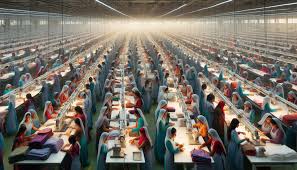Once upon a time, the mention of Bangladesh’s textile industry evoked images of small-scale, low-quality production. But fast forward to now, and the narrative has drastically shifted. Today, spinlagi
Bangladesh’s textile industry is a global powerhouse, a shining beacon of success in the world of textiles and garments. It’s a story of resilience, innovation, and sheer hard work, and it’s about time we delved into this remarkable transformation.
The journey of Bangladesh’s textile industry is nothing short of a Cinderella story. It all began in the 1970s, when the industry was still in its infancy. The sector was plagued by numerous challenges, including lack of modern technology, inadequate infrastructure, and a dearth of skilled labor. However, the Bangladeshi entrepreneurs were not deterred. They understood the potential of the textile industry and were determined to transform these challenges into opportunities. The government also played a pivotal role, implementing policies that encouraged foreign investment, promoted skill development, and facilitated access to modern technology. The result? A phenomenal growth that catapulted Bangladesh into the global limelight. Today, Bangladesh is the second-largest apparel exporter in the world, with its textile industry contributing to a whopping 80% of the country’s total export earnings.
The success of Bangladesh’s textile industry is not just about numbers and statistics; it’s a story of empowerment and socio-economic transformation. The industry has created job opportunities for millions of people, many of whom are women. This has not only helped to alleviate poverty but has also empowered women, giving them financial independence and a voice in society. Moreover, the industry’s growth has spurred the development of ancillary industries, creating a ripple effect that has boosted the overall economy.
However, this journey hasn’t been without its bumps and bruises. From the tragic Rana Plaza collapse to criticisms about working conditions and wages, the industry has had its share of controversies. But each time, it has emerged stronger, implementing reforms and striving to improve. Today, the industry is making strides in sustainable and ethical production, with many factories adopting eco-friendly practices and ensuring fair wages and safe working conditions.
In conclusion, Bangladesh’s textile industry’s transformation into a global powerhouse is a testament to the indomitable spirit of the Bangladeshi entrepreneurs and the resilience of its workers. It’s a story that inspires and motivates, reminding us that with the right blend of policy support, innovation, and hard work, even the most daunting challenges can be overcome. As the industry continues to evolve and grow, one thing is certain: the future of Bangladesh’s textile industry looks brighter than ever.
Bangladesh’s textile industry has become a global powerhouse, and it’s not slowing down anytime soon. The industry’s success is a testament to the resilience, determination, and hard work of the Bangladeshi people. It’s a story of how a nation can transform its challenges into opportunities and emerge as a global leader. As Bangladesh’s textile industry continues its upward trajectory, it serves as a beacon of hope and inspiration for other developing nations. It’s a testament to the power of innovation, policy support, and entrepreneurial spirit. And as the world continues to evolve and slot thailand
change, one can only expect Bangladesh’s textile industry to reach even greater heights.



